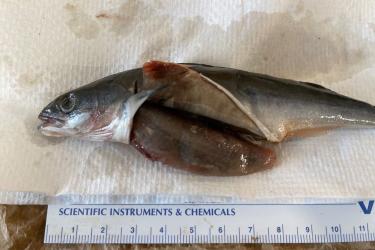Traces of DNA that fish species leave behind in the water can reveal the abundance and distribution of fish over large areas of the ocean as accurately as conventional fisheries survey methods, new research shows.
The research published today in Proceedings of the Royal Society B demonstrates for the first time that environmental DNA, known as eDNA, offers a less-expensive means of measuring populations of fish such as Pacific hake, or whiting, which supports the largest commercial fishery off the West Coast. Fishery managers and fishing fleets depend on such assessments to understand the distribution of species and how many fish fishing fleets can catch.
“This information is a staple for fisheries management, and eDNA can potentially provide it in a cost-effective way,” said Andrew Shelton, a research scientist at NOAA Fisheries’ Northwest Fisheries Science Center in Seattle and lead author of the research. “It gives you a snapshot of what fish are in the water without ever catching any.”
Scientists tested the power of eDNA off the West Coast by gathering water samples at multiple depths across 186 locations off the West Coast during hake surveys on the NOAA research ship Bell M. Shimada in 2019. The ship simultaneously employed acoustic methods that used sound to gauge fish populations. Scientists validate the acoustic findings by trawling on targets identified from the acoustics, which provides valuable information on the year-classes of hake as well.
eDNA Proves as Accurate as Acoustics
Researchers later analyzed the water samples in the laboratory for hake DNA, which the fish constantly shed into the environment as they swim. Charting the concentrations of hake DNA gauged the abundance of the species as accurately as acoustic and trawl findings across a swath of ocean about the size of South Carolina.
There are limits to the information that eDNA provides. While acoustic and trawl survey methods can often determine the size and age of fish, eDNA mainly shows abundance and distribution. Researchers said that eDNA results could be used initially to complement acoustic or other conventional survey methods, adding precision to stock assessments.
Earlier research demonstrated the value of eDNA surveys in assessing the presence of species in lakes, rivers, and coastal waters. For example, scientists last year used eDNA gathered from water near a wayward beluga whale that made a rare appearance in Puget Sound to determine it had likely come from the Arctic Ocean. However, the new research on hake is the first to employ eDNA at the large scale necessary to support ocean fishery management.
Stored water samples, such as those from the 2019 survey, also provide a snapshot in time that researchers can analyze later to determine the presence or distribution of other species. Advances in genetic science have made eDNA research possible by allowing scientists to detect and quantify even tiny fragments of DNA. This new genetic data provides new insight into the presence and abundance of species in the environment.
“We are not getting only the target species, we are getting information on all the other species that are out there at the same time,” said Krista Nichols, Genetics and Evolution Program Manager at the Northwest Fisheries Science Center and a coauthor of the research. She said she was surprised that eDNA produced such accurate data over such a large area. While the method is unlikely to replace existing survey methods anytime soon, she noted, “It is a powerful tool for understanding marine communities and the food web.”




